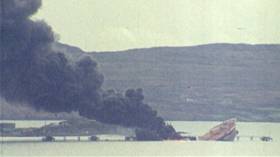Displaying items by tag: 40th anniversary
Betelgeuse Disaster: 40th Anniversary Memorial Service
#Coastal - People in their hundreds have attended a memorial service in Bantry, west Cork, to mark the 40th anniversary of the Whiddy Oil disaster in which 50 people died.
As RTE reports, the French-owned oil tanker the Betelgeuse caught fire and exploded as it was unloading crude oil at Whiddy Island in Bantry Bay in the early hours of 8 January 1979.
A lone piper led the Irish and French relatives past dozens of floral wreaths - among them flowers from oil companies Total and Chevron - into St Finbarr's Church today where the names of the deceased were read out.
The victims - 42 French, seven Irish and one English - were remembered during a bilingual service conducted by Bishop of Cork and Ross Dr John Buckley.
For more on the disaster which took place four decades ago, click here.
#FerryNews - Brittany Ferries resumed seasonal Cork-Roscoff service this Easter Bank Holiday, the sailings also celebrated the 40th anniversary of the route, writes Jehan Ashmore.
The 41,700 gross tonnage flagship, Pont-Aven launched the Ireland-France season having arrived in Roscoff yesterday morning. The 14 hours crossing marked the completion of the first round trip of the season that began on Friday night.
The 2,400 passenger/650 car capacity cruiseferry operates on what continues to be the shortest fastest route to France which has proved popular with Irish holiday-makers.
In 2017, Brittany Ferries carried more than 87,000 passengers, which was an increase of 4% on the previous season and contributing to the national economy. While France continues to be a popular travel destination for Irish travellers, the number of French people visiting Ireland showed no signs of waning as nearly 45,000 availed of the route, representing 52% of all passengers carried.
The service which asides providing a convenient direct route to the continent has also developed strong cultural ties between Ireland and France. This year sees the launch by Brittany Ferries économie no-frills Mondays sailings from Cork (from 30 April) in tandem to the flagship's routine Saturday service.
Brittany Ferries as previously reported are to launch the first ever direct Ireland-Spain route, Cork-Santander service starting on 2 May. A chartered in ropax, Connemara will operate the Bay of Biscay route and based on an économie no-frills service.
Rolling back the years and prior to the launch of the Cork-Roscoff route in May, 1978, a special promotional visit to Cork City centre quays took place on St. Patrick's Day. This involved the arrival of the 5,372 tonnes flagship Armorique.
The sleek profile of this 1972 French built ferry, the former Terje Vigen, was acquired three years later by the operator and renamed Armorique. The ship named after the Armorique Natural Park stretches from the Altantic Ocean to inland countryside. As for the ships' stylish lines combined with the French novely factor drew large crowds of curious Corkonians along the South Custom Quay, opposite Cork City Hall. On board were representatives from Brittany that travelled over and took part in the annual festival parade.
In addition a fleetmate, albeit even smaller, Penn-Ar-Bed made a special trip too that month to Cork and again to the same quay. The maiden commercial voyage was performed by Armorique on 27 May and proved an instant success with holidaymakers and freight. The venture paid off and had defied the critics at the time as to its viability.
The Armorique with a 700 passenger capacity and space for 170 vehicle decks, carried the vast majority of traffic as the end of season sailings were operated by Penn-Ar-Bed. This custom-built ferry of a mere 2,981 tonnes could only handle 420 passengers and 160 cars.
At the end of the first season, the Breton based operator announced that carryings were so encouraging and that they would in 1979 charter a freight-only ferry, Normandia. This allowed all freight to be carried separately and free-up space for passengers and holiday-based motorists on Armorique.
Services then used the former ferryport terminal in Cork at Tivoli downriver of the city, before operations transferred to the current Ringaskiddy Terminal in lower Cork Harbour. In the four decades of the Roscoff service, there have been 14 ferries, some appearing under different names. Also the role of three freight ro-ro ships operating the route.
Some ships it should be added made a once-off call to Cork (see Duc de Normandie) due to providing relief cover for routine ships going for dry-dock. This ferry for example had been deployed from the operators France-UK network which includes direct UK-Spain services.
The network in 1978 comprised of 5 routes, this included the launch of a new direct UK-Spain route, Plymouth-Santander. Over the past four decades the network has expanded to more than double the number of routes linking the four nations.
























































